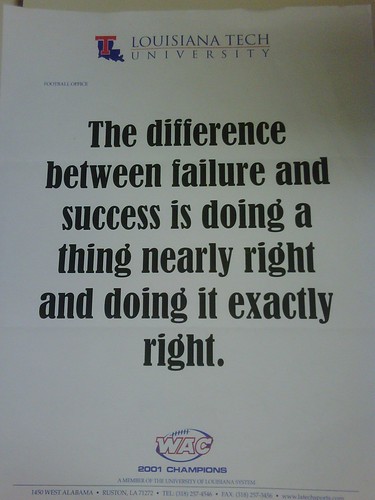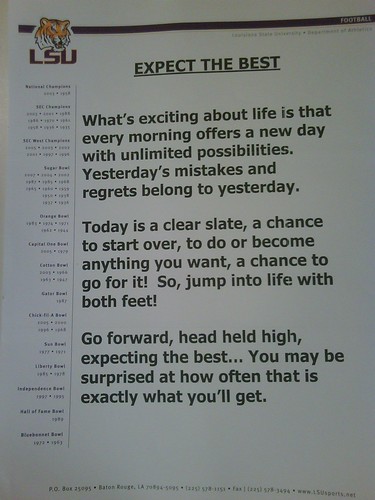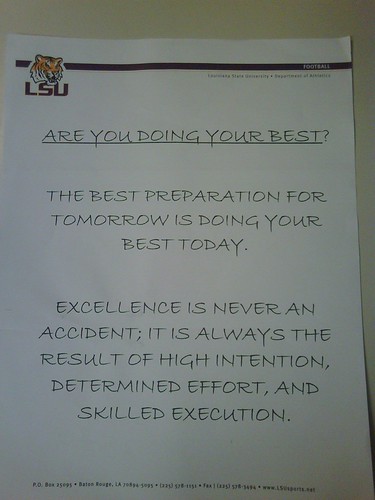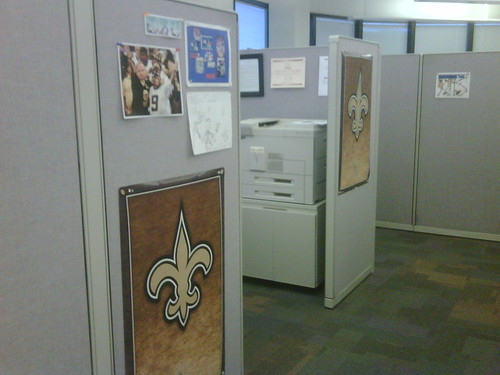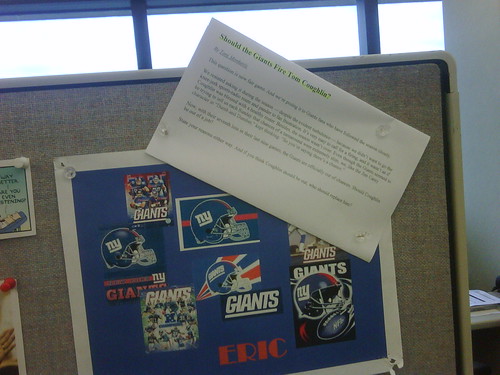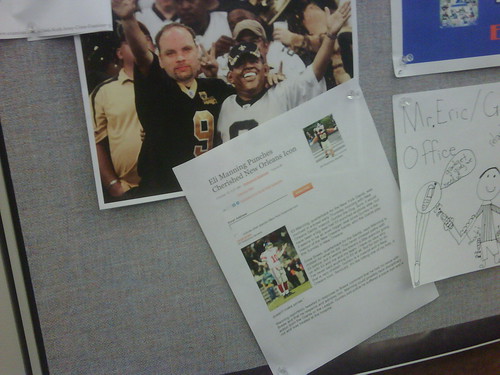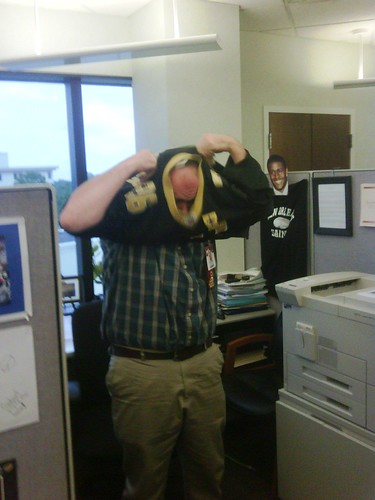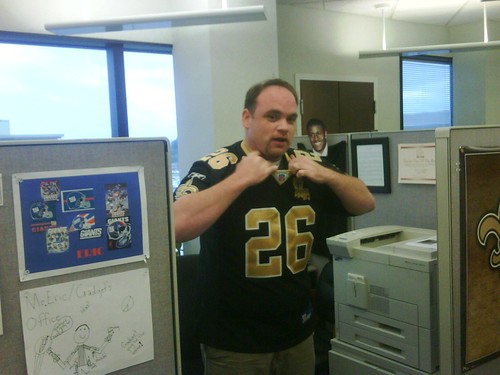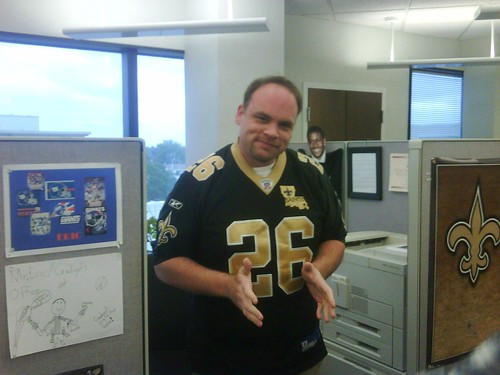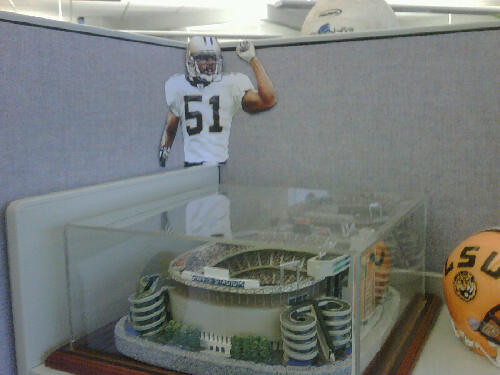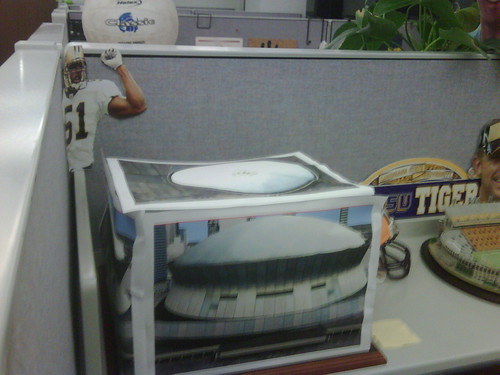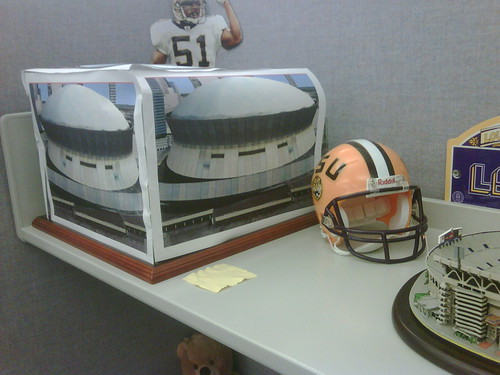This 3-step quick game consists of an immediate read of "Stick - to - Arrow" (then check down), with the Y working off the inside number of the hole defender (typically the MLB or SLB). The conflict created by the inside stem of the Y and the back expanding to the perimeter becomes too much to account for with underneath defenders.
Friday, October 30, 2009
STICK IT!
This 3-step quick game consists of an immediate read of "Stick - to - Arrow" (then check down), with the Y working off the inside number of the hole defender (typically the MLB or SLB). The conflict created by the inside stem of the Y and the back expanding to the perimeter becomes too much to account for with underneath defenders.
Tuesday, October 27, 2009
Great Ways To Destroy Your Players
Sometimes the best things to learn are the things NOT to do.....
We mean well, but there may be times when we unknowingly sap production from our team via the words we say, the way we treat people, or how we 'coach'
A few off the top of my head are;
Talking about how much a player sucks: not challenging or pressuring a kid to get better, but just berating his abilities in off-hand comments, that his team mates buy into (the real issue). The player will find himself alienating himself from the staff and his team mates (see the third example) in a vicious-cycle of defeatest attitude.
Best player excuse :here directly avoiding challenging a player to develop past himself or accepting flaws simply because he's just better than everyone else (therefore, even with mistakes, the kid is better than whats behind him). This emotional coddling inhibits self-pressure and growth.
Deliver all emotion, and no substance : hyping up a drill or responsibility through emotional transference (yelling and screaming), but not providing a clear direction in which to do accomplish what you want. "Throw Harder" / "Block somebody" come to mind.....telling the kid to improve his performance but not explaining HOW he can go about doing it, causing him to further doubt himself and begin sharing your frustration with him (only causing more errors for the player).
Demanding immediate production with no investment: prodding a kid into loading up the bar with plates, but does not have the motor skills developed to perform a squat. Sure, its pussified to have anything less than 225lbs on the rack, but if we haven't taught how to breathe, stand, sit, and explode (contract)....we end up cultivating an unsurmountable fear and trepidation to a major building block of success. You have to crawl before you can walk, and many times we will put kids in positions to have to be masters of 4-5 different skill sets, without affording them the time to gain mastery in one.
More feedback here;
http://coachhuey.proboards.com/index.cgi?board=general&action=display&thread=33652&page=1
Monday, October 26, 2009
Breaking Opera-Mini (v5)
Some great tips are found here
Non-touch users, don't forget Opera Mini's one and two-key shortcuts;
1 – Context Menu
2 – Scroll Up
4 – Scroll Left
5 – Zoom
6 – Scroll Right
8 – Scroll Down
# then 1 Enter URL
# then 2 - Search the Web
# then 3 - Find in Page
# then 4 - Start Page
# then 5 - Bookmarks
# then 6 - History
# then 8 - Settings
# then 9 - Saved Pages
# then # - Forward
* then 1-9 - Launch Speed Dial URLs 1-9
* then 0 - Reload Page
* then # - Toggle Landscape
* then * - Toggle Full Screen
* then Up - Open a new tab
* then Down - Close current tab
* then Right - Next tab
* then Left - Previous tab
Week 8: Slipping Past Northwood
Much respect to Northwood's Jamarcus Johnson (#6) and Mike Williams (#30) who dominated the night with competitive play and leadership.



Defense 10/23 @ Yahoo! Video
Geaux Hawkeyes: Outside Zone
Ferentz and Oline coaches, Reese Morgan and John McLaughlin ( no, not THAT guy ), stress key fundamentals for gaining leverage on defenders. The system they have used since Ferentz’s arrival in Iowa City has consistently featured a dominant run game (regardless of talent).
Their teaching progression for gaining leverage is as follows;
- Get underneath and inside
- Eyes on Target
- Flat Back
- Pad under chin
- Elbows in
- Hands Under
- Knees under chest
They stress the Olinemen to attack low-to-high, deliver an initial punch and then get the defender on his toes.
Once locked on to the target, if the defender tries to get away, they should accelerate their knees (and run over him). When the defender attempts to run away, that’s when guys get flattened because the inertia and combo blocking is too much to overcome.
The first step of the Olineman is a tight reach to the defenders' playside number. It doesn’t really matter if it is 3” or 6”, it all is relative to the athlete’s ability. The second step should be placed to put the lineman’s knee in the crotch (center of balance) and get vertical by driving his feet. From there, leverage is something they fight for with every step, looking to overtake the defender with movement.
HAWK RUN GAME from ragin caucasian on Vimeo.
Here we see their stretch run game utilized heavily throughout the game from various formations (both strong and weak). The following clips coming from their last drive in the game and the exciting last minute play (just basic 3-step slant-shoot concept) in the final 2 seconds is worth seeing again....HAWK STRETCH from ragin caucasian on Vimeo.
Having coached one, and also against five Hawkeye starters, I don't feel so bad about my situation now.Helmet to Helmet
Watching the Hawks battle the Spartans this weekend, there were quite a few vicious hits taking place. Two of which took out two phenomenal players (whom I've had the displeasure of trying to defend in the MAC), Brett Greenwood (#30) and Colin Sandeman (#22).
In the clip below, Sandeman gets blindsided with what would appear to be an other wise innocuous hit, but the neurological impact can be clearly seen. In light of the recent research of brain trauma and the long-term degenerative impact, this may amp up how these injuries are dealt with by training staffs.
But more importantly (for coaches), as Head Coach Mark Dantonio protests, defensive back, Jeremy Ware, was flagged for a 15 yard penalty of unnecessary roughness. From how we coach form tackling, Ware was in textbook position and presented his chest as the tackling surface.
shoots @ Yahoo! Video
eye opener @ Yahoo! Video
It just so happened that his helmet made contact with Sandeman's helmet. From a technique standpoint, I am unsure what Ware could have done to consciously prevent the injury (as his head naturally dips in anticipation of the hit as the chest makes contact).
See Malcolm Gladwell on Brain Injuries in Football , Brain Injuries and the NFL , Concussions Management in Sports
Further commentary here;
http://coachhuey.proboards.com/index.cgi?board=general&action=display&thread=33694
Monday, October 19, 2009
Rivalry Week
Friday, October 16, 2009
Get Back to Fundamentals: Escape!
The get-off, separation, and escape have to be conditioned into defenders as the rhythm in which they operate....if they are STILL ENGAGED with blockers after the 5th step, you have problems. Those offensive linemen / blockers don't have the ball!
There shouldn't be any thinking involved in this equation at all though. The WAY they are supposed to be playing the position should require very little mental processing, because it should be the same every snap;
- Align
- Stance
- Get-off
- Punch / separation
- Leverage
- Escape
Escape requires no more thinking than a hand strike block in Karate.....that's all this is....muscle-memory response
Also, we should be conditioning them to accomplish each movement in coordinated footsteps. This isn't unmetered "free time", it is a choreographed dance they need to be working with. They should be making contact on the first step, seperating/leveraging on the 2nd step, etc....just teaching get-offs on air has really no game time application. Getting them from the coiled hips (stance), to contact, to extension (seperation) is what is going to determine the line's success on game day
Just be sure the DL is gaining separation from the Oline at the snap. Getting off and into Olinemen is not what you want. Once they have uncoiled their hips (after get off) they are already beat (there is no way to work an escape if the hips are not coiled). If they do this, then it just becomes a wresting match of fatties (common at lower levels). Dline should keep their hips away from the oline at all times, and only close that distance when they are working an escape (and then push their hips tight past the Olineman's hips).
Week 7: Falling to Haughton
Thursday, October 15, 2009
Bo Pelini: Defensive Philosophy
As the Huskers press on to an inspiring turn around season, one can appreciate the hustle and determination Pelini instills in his players. Today's offering is Pelini speaking of his approach to building and coordinating defensive units (showcased here at the peak of his tenure at LSU).
Bo Pelini Defensive Philosophy Clinic (pgs 15 -18)
( located at http://sitekreator.com/brophyfootball2/main_page.html )
Audio of the lecture
( located at https://docs.google.com/file/d/0B3p5wkumv513N2IyMjc2MTAtMmNhYS00NzI4LWEzYjAtZDMwYmIyNTA3ZjFi/edit?usp=sharing )
Player Spotlight: #31 K.Pitre
After dedicating himself to practice and weight sessions, Kevin finished the summer with a 235 lbs power clean, 355 lbs squat, and a 265 lbs bench. Those numbers are staggering.....then you have to keep reminding yourself he is only 16 years old!
Now into his Junior year, Kevin has become a dominant force on the defense, and is a violent, offensive eraser on the perimeter.
Looking to study broadcasting after high school, he is improving his now cumulative 2.5 GPA to set himself up for continued success and achievement.
Wednesday, October 14, 2009
Nick Saban: Program Maintenance
“It’s not a tattle-tale thing. It’s more of him keeping up with what everybody is doing. … Everybody. He knows everything that’s going on with every player on the team. He’s completely on top of it.”
Monday, October 12, 2009
Player Spotlight: #63 C.Jones
Coming into the season, Carlton was boasting a 3.7 GPA (18 ACT his junior year), 255 lbs Power Clean, 330 lbs squat, and a 275 lbs bench. This 6'2", 230lbs athlete and outstanding young man is destined for future success due to a supportive family and relentless work ethic.
Week 6: Downed Woodlawn
In an exciting contest (that probably should have been more lopsided), we had the opportunity to be presented with beating press man coverage for the first time. Using fundamental solutions, we executed a game plan to start the second half, dictating coverage and fronts to set up what we'd prefer to call (optioning, lead-runs, and freeze tempo to control their 0-coverage pressure and force them back into cover 3 looks).
10/02/09 O @ Yahoo! Video
10/02/09 D @ Yahoo! Video
The two district leaders also fell off their perch, both losing, sending the 4A District 1 conference playoff hunt into a race towards November.
This week we face, a near mirror-image of ourselves in Haughton.
Thursday, October 8, 2009
Nick Saban: Middle of the Field Safety Coverage Principles (part III - Cover 1)
Just like it sounds, man-free coverage is man-to-man defense with a free safety in the deep hole (and a linebacker in the shallow hole). Players simply line up and play the respective man across from them.
- Corners always take the first receiver outside (and use the MOF divider just like in C3)
- The Strong Safety displaces to the second receiver
- The Mike and Sam play the backs respectively (Sam has first back out strong / Mike has third back)
- The Will takes the first back out weak or the second receiver weak.
- “Funnel” when LBs have 3 on 2 versus the backs
- “Alert” when LBs have 2 on 1 versus the backs.










